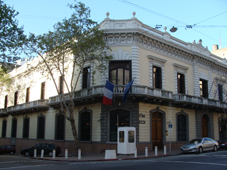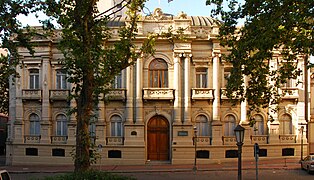
Montevideo is the capital and largest city of Uruguay. According to the 2011 census, the city proper has a population of 1,319,108 in an area of 201 square kilometers (78 sq mi). Montevideo is situated on the southern coast of the country, on the northeastern bank of the Río de la Plata.

Colonia del Sacramento is a city in southwestern Uruguay, by the Río de la Plata, facing Buenos Aires, Argentina. It is one of the oldest towns in Uruguay and capital of the Colonia Department. It has a population of around 27,000.

Ciudad Vieja is a historic neighbourhood in Montevideo, the capital of Uruguay. Located in a peninsula at the entrance of the natural port of Montevideo it was founded in 1724 as a walled city by the Spanish Empire, after the independence of Uruguay the city rapidly grew outwards and the Ciudad Vieja remained as one of the central neighbourhoods, nowadays it serves as one of the main office districts of Montevideo, housing multiple banks and institutions, but also as one of main tourist attractions in Uruguay due to its historical significance and classical architecture.

Plaza Independencia is the most important city square in Montevideo, Uruguay, laid out in the 19th century in the area occupied by the Citadel of Montevideo. In its center is a monument to General José Gervasio Artigas, and below it, his mausoleum. Artigas, the country's national hero fought in the Latin American wars of independence against the Spanish Empire, but also against the Portuguese Empire.

Avenida 18 de Julio, or 18 de Julio Avenue, is the most important avenue in Montevideo, Uruguay. It is named after the date on which the country's first Constitution was sworn in, on July 18, 1830.

Artigas Boulevard is a boulevard in Montevideo, Uruguay. It runs from the Rambla at Punta Carretas to the Rambla at Capurro-Bella Vista, going north for about 6.5 kilometers and turning 100° west. It is an important connection road, linking the central barrios of the city, with access to different national routes.

The Rambla of Montevideo is an avenue that goes all along the coastline of Montevideo, Uruguay. At a length of over 22.2 uninterrupted kilometres (13.7 mi), the promenade runs along the Río de la Plata and continues down the entire coast of Montevideo. Since all the southern departments of Uruguay are against either the Río de la Plata or the Atlantic Ocean, they all have ramblas as well. The Rambla is an integral part of Montevidean identity and has been proposed as a World Heritage site.
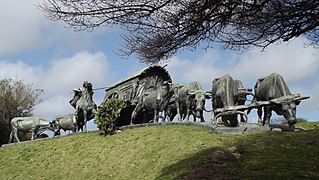
Parque Batlle, formerly Parque de los Aliados, is a barrio and a major public central park in Montevideo, Uruguay. It is named in honour of José Batlle y Ordóñez, President of Uruguay from 1903-1907 and 1911–1915.

Aguada is a barrio of Montevideo, Uruguay. Its name indicates water flow and originates from the springs and well it used to have which supplied the original city and the boats with drinking water.
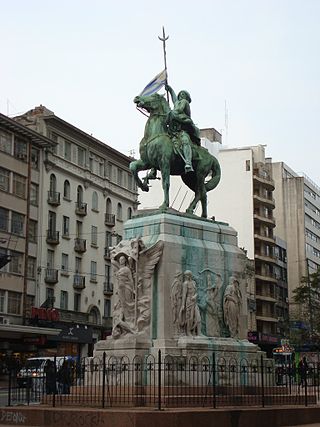
Cordón is a central barrio of Montevideo, Uruguay, located directly East of the Centro. Its main avenue is 18 de Julio Avenue. It is delimited by Miguelete Str. and La Paz Str. to the North, Dr. Barrios Amorin Str. to the West, Canelones Str. to the South and Dr. Joaquin Requena Str., and Rivera & Artigas Avenues to the East.

Bella Vista is a barrio of Montevideo, Uruguay and part of the Capurro / Bella Vista composite barrio, with Artigas Boulevard separating the two.
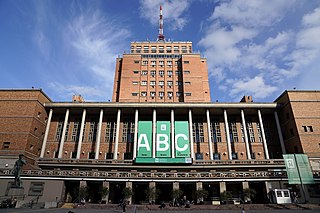
The Palacio Municipal de Montevideo is the seat of Montevideo government, located on 18 de Julio Avenue, in barrio Centro. It was designed by Uruguayan architect Mauricio Cravotto

Plaza de Cagancha is a public square in barrio Centro of Montevideo, Uruguay. Located on 18 de Julio Avenue, the main avenue of the city, it originated in 1836 as the central space of the layout of the "Ciudad Nueva", outside the limits of the walled area of the colonial period.

Libertador Avenue is a major avenue in Montevideo, Uruguay. It stretches north from the Legislative Palace in Aguada to Plaza Fabini in Centro, and is named after Juan Antonio Lavalleja, revolutionary figure and politician, who led the group of the Thirty-Three Orientals in the insurrection for the independence of Oriental Province.

Cuisine of Montevideo refers to the food cooked and served in the city of Montevideo, Uruguay. The cuisine served in this city is similar to the one served throughout the whole country of Uruguay, with beef being a staple of the diet along with the torta frita, a pan-fried cake.

Palacio Rinaldi is a building in Centro, Montevideo, Uruguay, located on the Plaza Independencia near its junction with the 18 de Julio Avenue, near the Palacio Salvo.

Edificio Lapido is a building on the 18 de Julio Avenue in Centro, Montevideo, Uruguay.
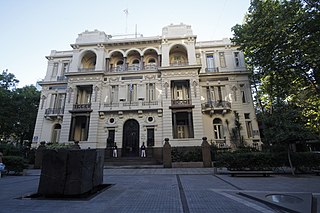
The Piria Palace is the headquarters of the Supreme Court of Uruguay. Located on the south side of the Plaza de Cagancha in Montevideo, on the Human Rights Passage, it was declared a National Historical Monument in 1975. In front of its main entrance is the Monument to Justice, a work by Rafael Lorente Mourelle.

Democracy Square is a road junction and public space in barrio Tres Cruces of Montevideo, Uruguay.






